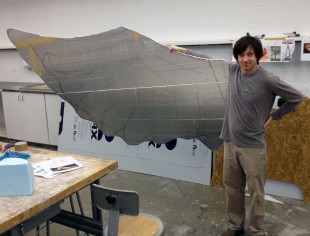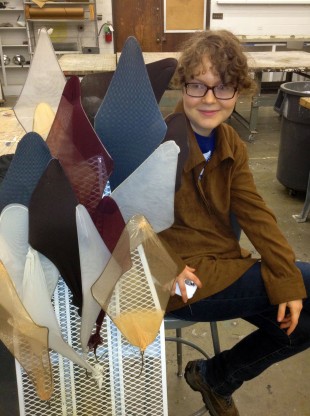Rice students build an owl on wheels for Houston’s Art Car Parade – and for course credit
In a cluttered art studio off the Sewall Hall courtyard, five students are in deep discussion about the shape of an owl’s wing.
Does it curve at the top, or is it smooth? What does a wing look like, anyway?
Pictures of owls are spread out on a table. Insects fly in through the open doors, attracted by the light on a warm evening. The students lean in over the cardboard wing they’ve cut, deliberating over shape and aerodynamics.
“Do we want to take this to the car?” someone asks. And the five of them steal away into the night with their cardboard wing, headed for the Oldsmobile Alero they are transforming into an owl.
Every Wednesday night about 13 students gather for ARTS 105, also known as Art Car 101. They’re building Rice’s entry for Houston’s Art Car Parade in May – and they’re getting an hour of course credit for it.

Students in ARTS 105 are turning an Oldsmobile into an owl for Houston's Art Car Parade. Photo by Greg Marshall
The idea for the course came from Greg Marshall ’86, Public Affairs’ director of university relations. He has arranged the university’s previous entries in the annual parade of crazy and colorful cars, a Houston institution organized by the Orange Show Foundation.
Art Car 101 is a collaboration, Marshall said, between the Visual and Dramatic Arts Department and the Oshman Engineering Design Kitchen, which worked together to create a “cross-disciplinary class.” He proposed the course as a way to involve “the entirety of the Rice University family” in a project that would celebrate Rice’s centennial — including students, staff, faculty and alumni.
The four instructors – who are contributing their time – are a perfect amalgamation of those groups: Two are faculty members, one is on staff and three are Rice alumni.
And they have backgrounds that make them ideal candidates to teach an art car class:
— Marshall has arranged the university Art Car Parade entries for the past several years, including last year’s “Centennial Sammy,” a Model T made in 1912. The 2008 entry, a single-molecule “nanocar” developed by Rice chemists, rode on the dashboard in a vial and won the parade’s Visionary Artist Award.
— Jay Miller, a visiting assistant professor of philosophy, is a sculptor and has worked with Stanley Marsh 3, the creator of the Texas Panhandle’s “Cadillac Ranch.” Miller’s academic research tends to focus on the social significance of art, including the meaning of collaborative projects.
— Natali Leduc ’07, who earned a Ph.D. in French studies at Rice, is an MFA candidate at the University of Houston. Leduc has a long history of creating both art cars and art bikes for the annual parade, and her work on bicycles was exhibited in Tulsa last year.
— And Richard Carter ’84 is an adjunct professor of computation and applied mathematics. He’s also creator and owner of the “Sashimi Tabernacle Choir,” an ’84 Volvo covered with more than 250 Big Mouth Billy Bass fish and lobsters, all singing classical opera.
The 2000 Oldsmobile was contributed by Tommy Brasher ’63 and Scott Brasher ’95, owners of Brasher Motor Co. in Weimar, Texas. (License plate: OWL100, a nod to the centennial.) And once the students are finished, the plain four-door sedan will be permanently transformed into a Rice Owl.
“We have students from all kinds of backgrounds – engineering, mathematics, the visual arts, the humanities – and all of them are working on this common goal,” Miller said.
Most of the students have “artistic bents,” Carter said, even if they’re not majoring in art. Claire Schaffer, for instance, a Lovett senior, is majoring in French – but she helped her parents work on two art cars when she was growing up in Houston. So ARTS 105 was an obvious choice for an elective.
“I like classes where I create something at the end – a project,” Schaffer said. “I was looking for creative outlets, and this popped up.”
In class that February evening, Schaffer was creating owl feathers by stretching old pantyhose over bent wire hangers. Leduc followed up with wire and a pair of pliers, securing each feather to part of a metal ironing board that once belonged to Schaffer’s grandmother.
“We’re still in test mode,” Schaffer said. Next week, the plan might be altogether different.

Lovett senior Claire Schaffer tries making feathers out of hosiery and hangers. Photo by Greg Marshall
The feathers, of course, must be sturdy enough to stay on a car driving 20 mph. Schaffer and Leduc took their feathered ironing board out for a test run in the courtyard.
“Run, Natali, run!” Schaffer called out, and they took turns careening across the concrete and trying to build up enough speed for some wind beneath their wing.
Meanwhile, in another studio off the courtyard, a trio of students and Miller were welding.
“Basically what we’re going to do,” Miller told them, “is create an armature for the front of the car – what will actually support the owl head.”
He gave a crash course on the basics of welding and showed his students how to use the MIG welder to connect four thin steel bars.
“One thing that’s really difficult about welding,” Miller told them, “is it gets so hot that it warps the metal and can throw your angles off a little bit. We have to be really careful.”
Welding masks were handed out. The whir of the machine was followed by a series of crackles and bright flashes. Sparks scuttled across the concrete floor and into the night.
Collaborative art projects like this, Miller said, are an “emerging creative process.”
“Especially this kind of creative project,” he said, “ties together so many different abilities and ideas – both creative and analytic – in a way that you often hear talked about but rarely see realized.”
The group hopes to have something to show visitors at the UnConvention in April. The car should be finished soon after that for a series of Art Car Parade events that culminates with the actual parade May 12.
“We realize the Houston Art Car Parade is something big and important,” Miller said. “We want to be a part of that.”


I am the editor of Artcar Nation a news and affairs magazine about artcars and we are very interested in this project.
We are keeping a close eye on the progress. See here. Thanks for the update.